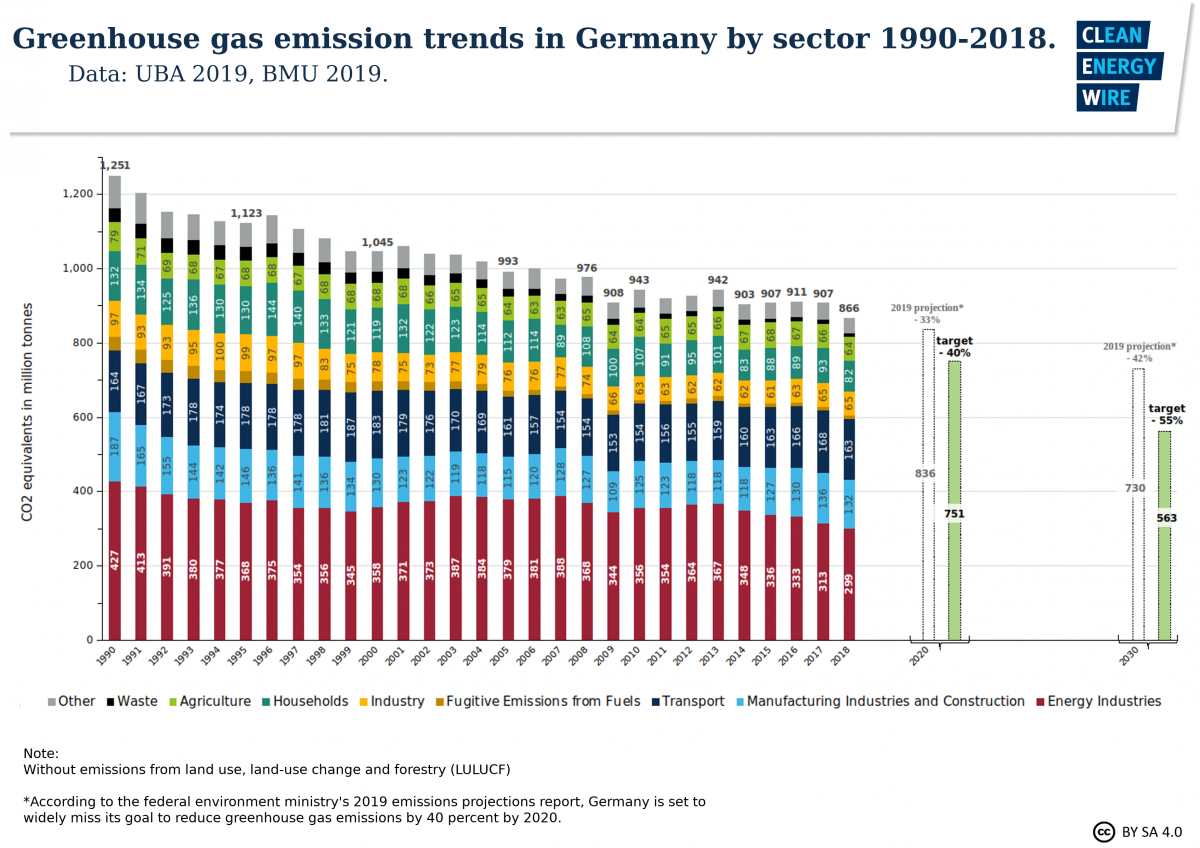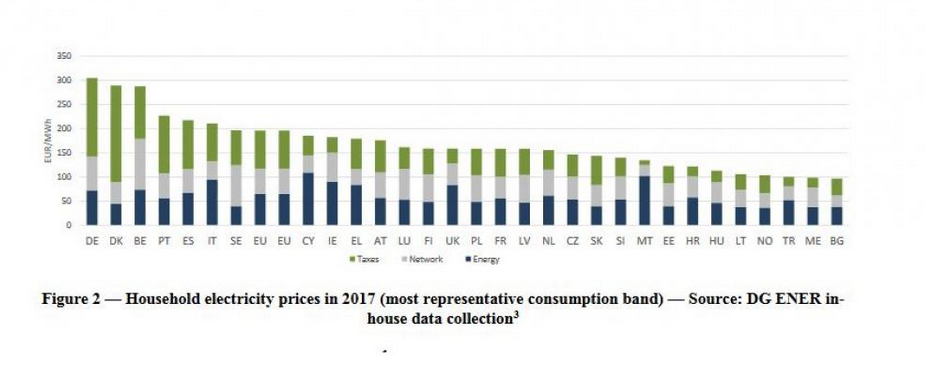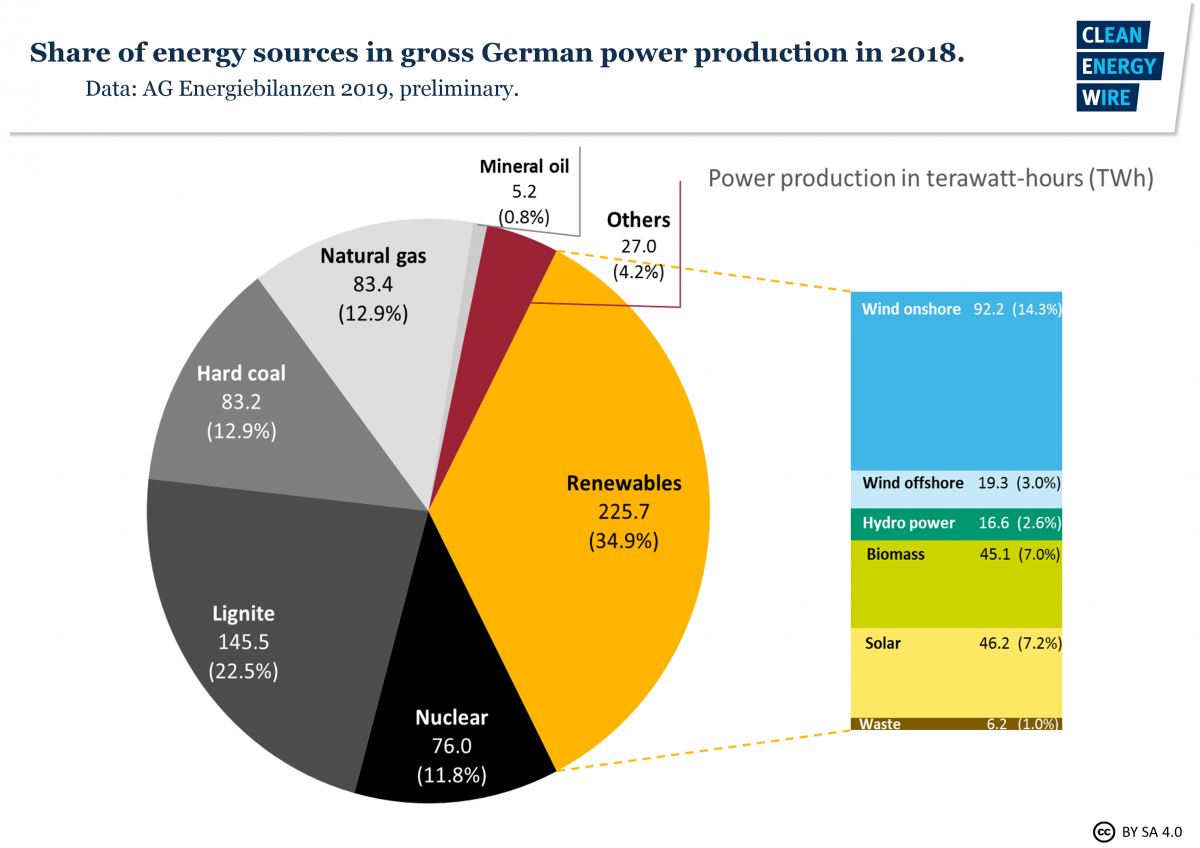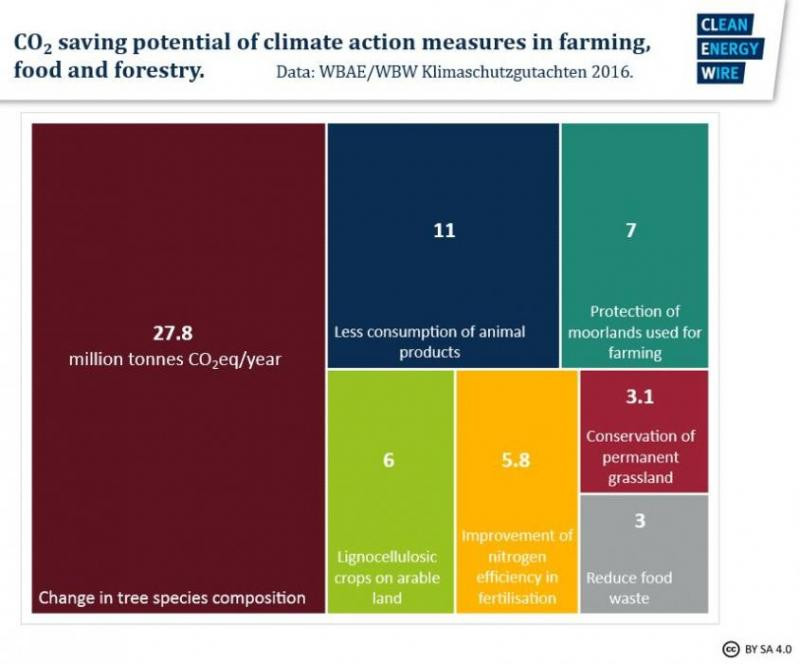Germany's Climate Action Programme 2030
The programme's context
The German government has obliged itself to contribute to the European Union's emissions reduction targets in line with the 2015 Paris Climate Agreement. At the UN Climate Action Summit in New York in September 2019, Chancellor Angela Merkel committed Germany to a goal of net-zero carbon emissions by 2050 and has said earlier that Germany supports a similar objective for the whole EU. The Climate Action Programme 2030 is seen as a crucial step in this regard [find the original file here]. It is the result of months of deliberations by members of Merkel’s coalition government and the country's "climate cabinet,” which consists of government ministers with portfolios that are especially relevant to climate action. The 173-page document lists concrete policy measures meant to ensure the mid-term CO2 reduction goals are achieved on the way to eventual carbon neutrality.
The 2030 climate targets stipulate a reduction of greenhouse gas levels by 55 percent below 1990 levels, which means carbon emissions have to fall from about 866 tonnes per year in 2018 to 563 million tonnes by the end of the next decade. Meanwhile, Germany is set to miss its non-binding 2020 target, which calls for to reducing emissions 40 percent. The environment ministry expects a reduction of roughly 33 percent in its latest emissions projections report.
The Climate Action Programme 2030 document says that Germany's climate targets mean "a change in our way of living and running the economy" and stresses that supporting the transition to clean energy and low-emission technology brings "great opportunities for Germany as a country of business, innovation and jobs." The government argues that investments under the programme will ultimately avoid even higher costs resulting from climate mitigation and adaptation, as well as the costs required to buy emissions allowances from abroad if it does not meet its climate targets under EU law.
Implementation and monitoring
All sectoral emissions reduction targets mentioned in the document arise from Germany's Climate Action Plan 2050, which sets the nation’s longterm climate goals. The government will make annual reduction targets legally binding for each economic sector, putting the onus on individual ministers that required measures in their portfolio are implemented. In order to create "objectivity" and "maximum transparency," the government says it will evaluate progress made with the help of an external expert committee
The climate cabinet, initially installed as a temporary institution, will be made permanent and charged with testing the "effectiveness, efficiency and accuracy" of all measures every year. If a given sector fails to make sufficient progress regarding the binding targets, responsible ministers will be obliged to come up with an "ad hoc programme" within three months to get back on track.
Based on this programme, the climate cabinet will then decide how measures can be "jointly adjusted" to make sure that the "underlying" targets are met. Alternatively, the government can also adjust the carbon budgets for each sector and for example shift reduction activities from transport to buildings or the other way around.
National CO₂ pricing mechanism and ETS reform
One major element of the Climate Action Programme 2030 is a proposal for a new national carbon pricing system that covers the transportation and buildings sectors [find a factsheet on the system here]. With the exception of aviation, these sectors are not currently covered by the existing European Emissions Trading System (ETS), which sets limits on carbon emissions from the energy sector and heavy industry.
The plan initially proposed starting with a fixed price of 10 euros per tonne of CO2 by 2021, but this provision had been amended in December 2019 following a backlash by state governments. A mediation committee between the national parliament (Bundestag) and the council of state governments (Bundesrat) agreed on a higher starting price of 25 euros per tonne and also to increase prices for the following years. Allowance prices would then rise to:
- 30 euros in 2022
- 35 euros in 2023
- 45 euros in 2024
- 55 euros in 2025
This gradual increase will ensure a "reliable price development,” allowing citizens and companies to get used to the new pricing system and invest in less carbon-intensive alternatives, the government says. Instead of targeting direct emitters like power plants, as the ETS does, the national system is aimed at companies that sell heating and transportation fuel.
Retailers then will have to purchase allowances, thereby creating a "trading platform" that later enables an auctioning and trading of allowances once the fixed price system transforms into a market-based system after 2025. If retailers require more allowances than Germany is allowed under its EU-defined emissions budget, they will have to purchase those allowances abroad. Retailers are expected to pass along much of the cost to consumers, raising the price of fuels like gasoline, diesel, and heating oil.
The plan calls for a ceiling on CO2 emissions that is set in 2026 and then going to be decreased further each year. That cap would be in line with national long-term emissions targets under the Climate Action Plan 2050 and with EU regulations setting emissions caps for non-ETS sectors. As of 2026, allowance prices will be set in auctions but are going to be confined by a minimum price of 35 euros and a maximum price of 60 euros per tonne. Boundary prices for 2027 will be decided in 2025.
The German government says it supports expanding the existing European ETS into an EU-wide system covering all sectors. As a first step, it announced its support for a "moderate" carbon floor price, or minimum price, in the existing ETS sectors energy and industry.
Compensation mechanisms for citizens
The government insists that all new revenue generated by carbon pricing should either be invested in new climate action measures or returned to citizens as compensation. It expects CO2 pricing in the buildings and transport sectors to bring in 18.8 billion euros by 2023.
In order to reduce the financial burden for consumers, Germany's trademark renewables surcharge, which customers pay with their power bill to support the expansion of renewable energy sources, will be gradually lowered over the next years. The government also plans to reduce other climate policy-related components of electricity prices, such as grid fees, to lower prices for households and businesses. The government insists that these changes will not reduce financial support for renewable energy, which ”will remain untouched.” Instead, these will be financed with the earnings generated by carbon pricing.
The renewables surcharge that power customers pay on their electricity bill stood at 6.405 cents per kilowatt hour (kWh) in 2019. It will fall by
- 0.25 ct/kWh in 2021
- 0.5 ct/kWh in 2022
- 0.625 ct/kWh in 2023
If the revenue from CO2 pricing increases, the "power price will be lowered further accordingly," the government says. This shift is meant to facilitate a gradual transition towards electrification in all sectors, by increasing the price of fossil fuels like diesel and heating oil while reducing the price of electricity.
Commuters will receive increased tax relief of 35 cents per kilometre if they travel more than 20 kilometres to their workplace until the end of 2026. Recipients of housing allowances will receive a ten percent increase in those allowances "to avoid social hardships" associated with rising heating costs.
Energy sector
The energy sector so far has made the largest cuts to carbon emissions of any sector and must continue to so in order to reach Germany’s 2030 climate targets. Its 2030 emissions target is a maximum of 183 million tonnes of CO2 and the government says the measures listed in the programme will bring an additional reduction of 83 million tonnes. According to government calculations, the amount of renewable power capacity connected to the grid needs to almost double over the next decade, from 118 gigawatts (GW) in 2018 to 200 GW by 2030.
Coal power
Coal-fired power plants accounted for over two-thirds of Germany's energy sector carbon emissions in 2018. A government-appointed commission has proposed phasing out all coal power by 2038 the latest, a target the government now says it will "implement in close coordination with the federal states.” The government’s plan would reduce the installed capacity of coal power from over 40 GW in 2018 to 17 GW by 2030. The government promises to enshrine the proposed coal exit into law by November 2019.
Renewables
Renewable energy is supposed to provide 65 percent of total power consumption by 2030, up from about 38 percent in 2018, according to the government’s plan. Onshore wind power must play a key role in meeting this goal, but the technology's expansion has run into obstacles, mainly due to regulatory conflicts with aviation authorities and lawsuits against new projects by citizens. In the first half of 2019, the net addition of new turbines fell to the lowest level in two decades. Germany’s economy and energy ministry together with the federal states has presented a plan to break the deadlock in wind power expansion.
The government says that any new turbines and new models replacing older ones (so-called “repowering”) must maintain a minimum distance of 1,000 metres from the nearest residential area. However, federal states and municipalities can opt out of this distance rule. The existing minimum distance in Bavaria, which is ten times the turbine's height (the “10H rule”) “will remain unchanged,” the government says. In addition, all municipalities will now receive part of the profits generated by turbines built on their land. A "regional bonus" in guaranteed remuneration is meant to ensure that turbines are distributed more evenly across the country and not primarily in the more windy northern states. The government’s plan calls for a total of 67-71 GW of onshore wind installed capacity by 2030.
As for offshore wind, the government proposes increasing the target from 15 to 20 GW of installed capacity by 2030. The support cap for photovoltaic solar power, currently set at 52 GW, will be removed completely. The government calls for solar PV installed capacity to reach 98 GW by 2030. The installed capacity of biomass is projected to reach 8.4 GW by 2030, while hydro power and other sources should reach 6 GW of installed capacity, the government says.
Transport sector
No other sector has made less progress in emissions reduction in Germany than transport, with CO2 output falling by about 0.6 percent since 1990. Emissions in the transport sector need to fall to no more than 98 million tonnes by 2030. At current rates, they will stand at about 150 million tonnes in that year, meaning that the climate action programme's measures need to induce additional reduction of over 50 million tonnes over the next decade.
Cars
The number of electric vehicles registered in Germany should reach 7 to 10 million by 2030 under the government plan. To reach this figure, allowances for company cars with batteries or plug-in-hybrid engines until 2030 and reduce taxes for purely electric company cars will be prolonged and the buyer's premium for passenger cars with electric, hybrid or hydrogen/fuel cell propulsion systems extended. It will also be raised for cars that cost up to 40,000 euros. In addition, federal states and municipalities will be allowed to set their own emissions standards for buses, taxis and rental cars. The motor vehicle tax will be based on total emissions per kilometre for any new car registrations as of 2021.
The government plans to bring the number of public charging points for electric vehicles to one million by 2030. Public funding for charging points will be guaranteed until 2025 and carmakers and energy companies be encouraged to expand the nation’s charging infrastructure. If required volumes cannot be achieved through market mechanisms, the government says it might regulate construction by law. All service stations in Germany will be ordered to install charging points, and the construction of fast-charging points could be counted as a decarbonisation effort for oil industry companies. The government will also offer funding to support the construction of charging points on private or company premises remove regulatory hurdles. A "national control room" for electric mobility will be set up to coordinate the charging infrastructure expansion.
The government also says it wants to boost the use of bicycles as an alternative to cars, both in urban and in rural areas. It will introduce a set of new traffic laws that give bicycles precedence over cars and plans to scale up investment in bike infrastructure, including new bike lanes and traffic signs. However, the government acknowledges that bike infrastructure is not solely an issue of financing, and says there needs to be "a willingness for the reallocation of urban space" to cyclists at the expense of car drivers.
Renewable power-based fuels will play a key role in the transport sector's transformation, the government says, and the new programme calls for creating the conditions for large-scale production in electrolysis and refinery procedures. To increase the role of bioenergy in transportation fuels, more emphasis will be put on technology to base biofuels on waste rather than on crops. The document says that an expansion of land used for energy crops "is not to be expected” and restrictions will also apply to imported bioenergy components.
Rail traffic & Public transport
Annual federal support payments for the expansion of public transport systems will be raied to one billion euros per year by 2021, and two billion euros per year by 2025. In 2030, 50 percent of all city buses ought to be electric, the government says. The plan will support several "model projects" for urban public transport, for example a year-round ticket for 365 euros, with the goal of reducing car use.
Together with the national train service provider Deutsche Bahn, the government will invest about 86 billion euros by 2030 to expand and modernise Germany’s railroad network. In order to make long-distance train rides more attractive to customers, the government will reduce the value added-tax, a change expected to make train tickets about ten percent cheaper.
Freight transport
One third of all freight traffic should use either electric vehicles or electricity-based fuels by 2030, the government says. The lorry toll will be reformed with the goal of making climate-friendly engines more attractive.
Fuel cells and synthetic fuels produced with power-to-x technology will play an important role in particular for future freight transport, the government says. The proposal commits to supporting the "development and large-volume scaling" of electrolysis and other refinery systems for manufacturing electricity-based and climate-neutral fuels.
The government also supports using longer freight trains - up to 740 metres in length - and the electrification of further stretches of the railroad network. Both should bring more freight off the roadways and onto trains. Inland waterway transportation will also play a greater role in the future, the government says. Vessel operators will receive incentives to use low-emission fuels and ultimately will be required to do so by law.
Aviation
The government wants to do away with "flawed incentives" leading to the super-low costs of some airplane tickets. It plans to increase the aviation levy by 2020 to avoid the use of so-called "dumping prices” by airlines. New regulations will require that tickets cannot be cheaper than the combined costs of applicable taxes, surcharges and other fees.
According to a legislative draft by the government, the air traffic tax will increase for short-haul from 7.50 euros to 13.03 euros, medium-haul from 23.43 euros to 33.01 euros and long-haul from 42.18 euros to 59.43 euros.
Buildings sector
The buildings sector is responsible for 14 percent of Germany's total emissions, which translates into 120 million tonnes of CO2 per year. Emissions have to fall to 72 million tonnes by 2030. Withouth further measures, emissions reduction would be no greater than 90 million tonnes, meaning that programme is meant to contribute a further 18 - 20 million tonnes, the government says.
As a complement to existing support programmes in the buildings sector, energy-efficient retrofitting of buildings will become tax-deductible by 2020. The tax deductions will reduce the cost of installing new insulation or replacing old heating systems or windows by up to 20 percent.
A "swap premium" for old oil-fired heating systems will repay up to 40 percent of the costs for a new and more efficient system. In addition, the government plans to legally ban the installation of new oil-fired heating systems as of 2026, if more climate-friendly alternatives are available. Energy consulting services will be made mandatory in certain situations, for example if a building changes ownership. Costs will be covered by existing support programmes.
In order to enhance the government's role-model function in building modernisation, public buildings will be held to higher efficiency standards and have to integrate climate-friendly technology solutions if possible, the government says.
Agriculture and forestry sector
The agriculture sector should emit no more than 61 million tonnes in 2030 but at current emisison reduction rates it will rather stand at about 67 million in that year. The government thus hopes to induce reduction of a further 6 - 9 million tonnes.
The government is proposing new regulations for the use of fertilisers in agriculture, to reduce excess levels of nitrogen and cut ammoniac and nitrous oxide emissions. It will support the use of airtight liquid manure storage and low-emissions spreading technology to reduce nitrogen levels. The new plan also supports the use of livestock manure for biogas production an includes better support for organic farming.
The government will support livestock farming in line with animal protection and emissions reduction goals, and plans to create a national strategy to reduce food waste. It wants to better exploit the capacity of soil to act as a carbon sink by supporting the targeted planting of carbon-absorbing plant species and other measures, including better protection and restoration for moor- and wetlands.
More wood should be used as a construction material and the reforestation of Germany’s forests should be intensified, the government says. Moreover, the composition of plant species in forests should be adapted to changing weather patterns to make these carbon sinks more resilient to heat waves and droughts.
Industry sector
Emissions of CO2 from heavy industry should fall to a maximum of 143 million tonnes per year by 2030, the government says. According to official estimates, that means reducing annual emissions by about 45 million tonnes from current levels.
According to the plan, the government will streamline support and counselling for industrial companies seeking to reduce their carbon footprint and offer a “one-stop-shop.” A national decarbonisation programme will look into new methods to cut emissions in particularly hard-to-tackle industrial processes, like the production of cement and steel.
The goal will be to optimise production processes and increase the use of renewable energy sources and renewable raw materials. "The goal is also to allow German industry to unlock new export markets through innovative climate technology and to contribute to international climate action through technology transfers," the government says. It also wants to better exploit "the high CO2reduction potential" of industrial waste heat, especially by integrating industrial facilities into district heating systems.
Carbon storage
Carbon storage and carbon utilisation technologies should be researched more, especially for industry emissions that are difficult to avoid. The government says that these procedures are essentially "indispensable" for achieving climate-neutrality by 2050. It says it wants to initiate a dialogue process with stakeholders to increase the acceptance of carbon storage. A possible storage location could be the "deep subsoil" of the North Sea.
Climate-friendly administration
The government says federal authorities and national administrations have a role-model function to fulfil. Besides the planned energy-efficient retrofitting of public buildings, it therefore plans to make all of its everyday operations climate-neutral by 2030.
This should be achieved with an environmental management system to spread best practices in energy efficiency and climate-friendly procurement among all ministries; by requiring that 100 percent of new government vehicles (except heavy duty vehicles) have alternative engines by the end of the next decade; by making the government’s IT-infrastructure more sustainable; and by cutting travel emissions through the increased use of videoconferences.
Financial sector
Germany's planned sustainable finance strategy is supposed to accompany other measures in the programme. The government says this will have rather indirect effects but also announced some concrete measures, like issuing green state bonds and aligning public investment funds to sustainability principles.
It also plans to develop a "communication strategy" to raise awareness among citizens of green and sustainable finance options. The plan proposes an enhanced role for Germany's publicly-owned development bank KfW in assisting the economy's sustainable transformation.
Funding
The government says its goal of maintaining a balanced budget without any new debt will be respected under the climate programme. Germany's current Energy- and Climate Fund will continue to be the central funding instrument for energy transition and climate action measures. The total cost of those measures is projected to top "a three-digit billion euro sum" by 2030.
The Climate Fund will draw from carbon pricing revenue, which will also compensate other losses in the government budget related to climate measures, such as tax rebates. This is supposed to ensure that the budgetary effect of climate action remains neutral.





